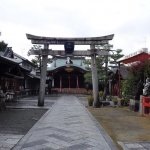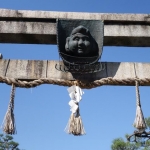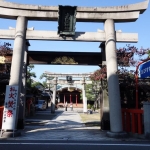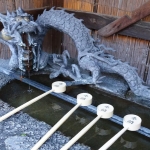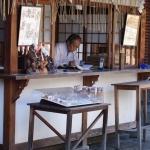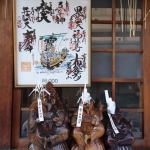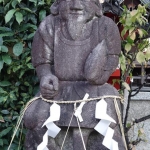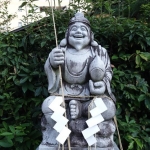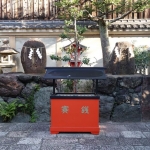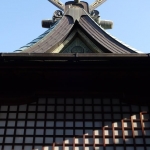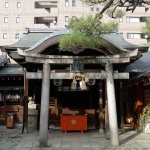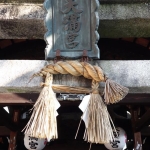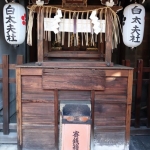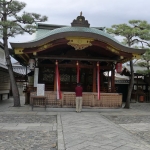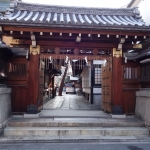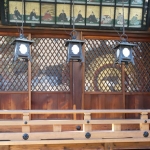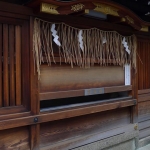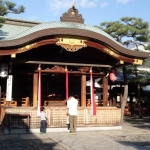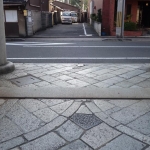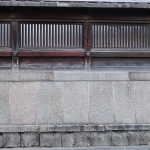Ebisu-jinja
Arriving in the daytime
or whenever you come–
welcome, Ebisu!
–Hakuin
This shrine was in my neighborhood, and I enjoyed visiting it many times.
Ebisu is one of the Shichifukujin, the Seven Lucky Gods of Japanese folklore, who are traditionally associated with the New Year. He is however, the only one of these gods to originate in Japan. The other six gods all came from China and India. You can see images of Ebisu around the shrine, whether in stone carvings or on the various goods on sale. He is always shown laughing, and he often holds a rod and fish, usually a red bream which is associated with celebration. The story of Ebisu is inspiring, as he wasn’t born lucky, and he overcame much hardship to become one of Japan’s most popular gods.
According to medieval legend, Ebisu was born so terribly deformed and handicapped that his own parents rejected him. Cast out to sea in a boat woven from reeds the poor infant was discovered by a fisherman who raised him as his own. Despite these hard beginnings, he grew strong under the care of his adopted family. Although he still walks with a limp, and remains hard of hearing, he never stopped smiling and laughing.
Now he is considered a god of good fortune and appropriately the patron of fishermen, working men and children. By overcoming adversity with cheerful perseverance, Ebisu sets a good example to those who would make their own good luck by working hard with a positive attitude.
Though Ebisu Shrine is of the Shinto folk religion, it has strong connections with nearby Kennin-ji, a Buddhist site. Legend has it that Kennin-ji’s founder, Eisai, was traveling back from China, when his ship was hit by a terrific storm. Fearing that the ship would sink, Eisai prayed to Ebisu (who also happens to be the guardian deity of seafarers) and the storm swiftly passed. When Eisai constructed Kennin-ji, he also gave thanks to Ebisu for his safe return to Japan, by having a shrine built in the god’s honor. It may seem odd that Eisai respected another religion in this way, but in Japan, religions like Shinto and Buddhism are not seen as mutually exclusive and it is common for people to practice the rituals of both.
Toka Ebisu
The first major festival of the year in Kyoto is Toka Ebisu. “Toka” means the tenth day, and Ebisu is the god of good fortune and prosperity. Though centered on the 10th of January, this festival actually lasts for five days from the 8th until the 12th. During this time thousands of visitors crowd into Ebisu-jinja to conduct a simple ritual of prayer for ongoing success in their work and business.
Many people buy branches of lucky bamboo grass, called Fuku-Zasa which has been blessed in a special ritual by a shrine maiden. They then buy more lucky charms and talismans, which they attach to the bamboo branch. These charms come in all kinds of designs, but two of the most common are treasure boats for wealth and red sea bream for future success.
When you reach the main altar, throw a coin into the donation box. A five yen piece is considered lucky but any coin will do. Step back and then perform the following simple ritual.
* Bow twice deeply.
* Clap twice.
* Spend a moment in prayer.
* Bow once again.
Ebisu is thought to be hard of hearing, so after praying people file past a wooden board to the left of the main altar and knock on it as they go by. This is said to wake Ebisu up and get him to pay attention to your prayers.
Throughout the festival, shrine maidens perform a ritual dance called kagura. This simple dance to pipe and drum has its roots in ancient shamanic rites held to summon the gods. At Ebisu Festival it is performed to purify and bless the lucky branches of bamboo grass. When sales of these branches are slow, the dances take place every fifteen to twenty minutes, but as the shrine gets busier the dance is performed almost continuously.
Toka Ebisu is also a good opportunity to see maiko, the apprentice geisha or geiko of Kyoto. On the afternoon of January 11th, maiko from the geiko district of Gion sit in the main hall and give out lucky rice cakes and branches of lucky bamboo grass. In the evening maiko from the Miyagawa district do the same.
Yudate Kagura
This is a Shinto ritual in which a Shrine Maiden uses a bunch of sacred “Sasa” (bamboo) leaves to splatter hot water around.
Being splattered with this water is believed to protect you from diseases, natural disasters and bad luck in general.
Hatsuka Ebisu
Ebisu Shrine holds a second similar festival on the 19th and 20th of October called “Hatsuka Ebisu”. Hatsuka actually means “20th day”. This festival has its roots in Edo times when merchants traveling back from Edo (modern Tokyo) would give thanks at the shrine for a safe and successful journey. People still give thanks here, and pray again for their businesses and for safety in their homes.


